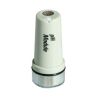Extech ExStik pH Meter
Features
- Display indicates when the reading is stabilized
- Memory records and recalls 15 readings
- Analog bargraph displayed on LCD
- Expedited repair and warranty service
- Lifetime technical support
- More
Overview
The Extech ExStick pH Meter provides fast and easy on-the-spot pH measurements. The flat surface electrode conducts measurements in liquids, semi-solids, and solids.
Data Capabilities
The Extech ExStik pH Meter simultaneously displays pH and temperature, as well as an analog bargraph for sample trends. The memory records and recalls 15 sequentially tagged readings allowing the detection of changes over time. The display indicates once the reading has stabilized. The CAL alert tells users when it is time to recalibrate, and the RENEW indicator when it is time to replace the electrode. The meter takes a 1, 2, or 3-point calibration that automatically recognizes buffer solutions. Additional meter functions include data hold, automatic power off, and low battery indication.
- pH range: 0 to 14pH
- pH resolution: 0.01pH
- pH accuracy: ±0.01pH
- Temperature range: 23 to 194°F (-5 to 90°C)
- Temperature resolution: 0.1°
- Temperature accuracy: /±1°C
- Measurement storage: 15 tagged (numbered) readings
- Display: multifunction LCD with bargraph
- Dimensions: 1.4 x 6.8 x 1.6" (35.6 x 172.7 x 40.6mm)
- Weight: 3.8oz (110g)
- Warranty: 1 year (meter)
- (1) ExStick meter
- (1) Flat surface pH electrode
- (1) Protective sensor cap
- (1) Sample cup with cap
- (4) 3V CR2032 button batteries
- (1) 48" (1.2m) neckstrap
In The News
Ocean acidification: University of Washington's giant plastic bags help control research conditions
With oceans becoming more acidic worldwide, scientists are getting creative in designing experiments to study them. For example, one group at the University of Washington is using giant plastic bags to study ocean acidification. Each bag holds about 3,000 liters of seawater and sits in a cylinder-like cage for stability. The group at UW, made up of professors and students, is controlling carbon dioxide levels in the bags over a nearly three-week period, during which they are looking at the effects of increased acidity on organisms living near the San Juan Islands. “These mesocosms are a way to do a traditional experiment you might do in a lab or classroom,” said Jim Murray, professor of oceanography at the University of Washington.
Read MoreNOAA Alaska buoy network to monitor North Pacific ocean acidification
National Oceanic and Atmospheric Administration scientists detected signs of ocean acidification in the waters that hold the vulnerable and valuable fisheries of the North Pacific off the coast of Alaska, but they only had a snapshot of the action. “We know that in this place were important commercial and subsistence fisheries that could be at risk from ocean acidification,” said Jeremy Mathis, a NOAA Pacific Marine Environmental Laboratory researcher and professor at the University of Alaska Fairbanks. To understand how ocean acidification affects the North Pacific, NOAA scientists created a mooring network that collects constant in situ data on parameters contributing to acidification. They hope it will reveal seasonal trends and patterns left out by their snapshots.
Read MoreResearch in the Reserve: Promoting Interdisciplinary Conservation at the Great Bay National Estuarine Research Reserve
On an early winter day in 1973, a helicopter buzzed over Durham, New Hampshire, just a few miles from the Atlantic Ocean. One of the helicopter’s guests, oil magnate Aristotle Onassis, owner of Olympic Refining, looked east of town and saw what he hoped would become the world’s largest oil refinery. Instead, he saw the Great Bay; thousands of acres of green coastal forest, mud flats, salt marshes, and estuarine tidal waters stretching over the land toward New Hampshire's small Eastern coastline. Onassis likely also saw a group of Durham residents staked out on the bay’s coast, ready for him to pass overhead. While out of place in the natural setting, an obvious message was spelled out in red paper: “Not Here.
Read More
















